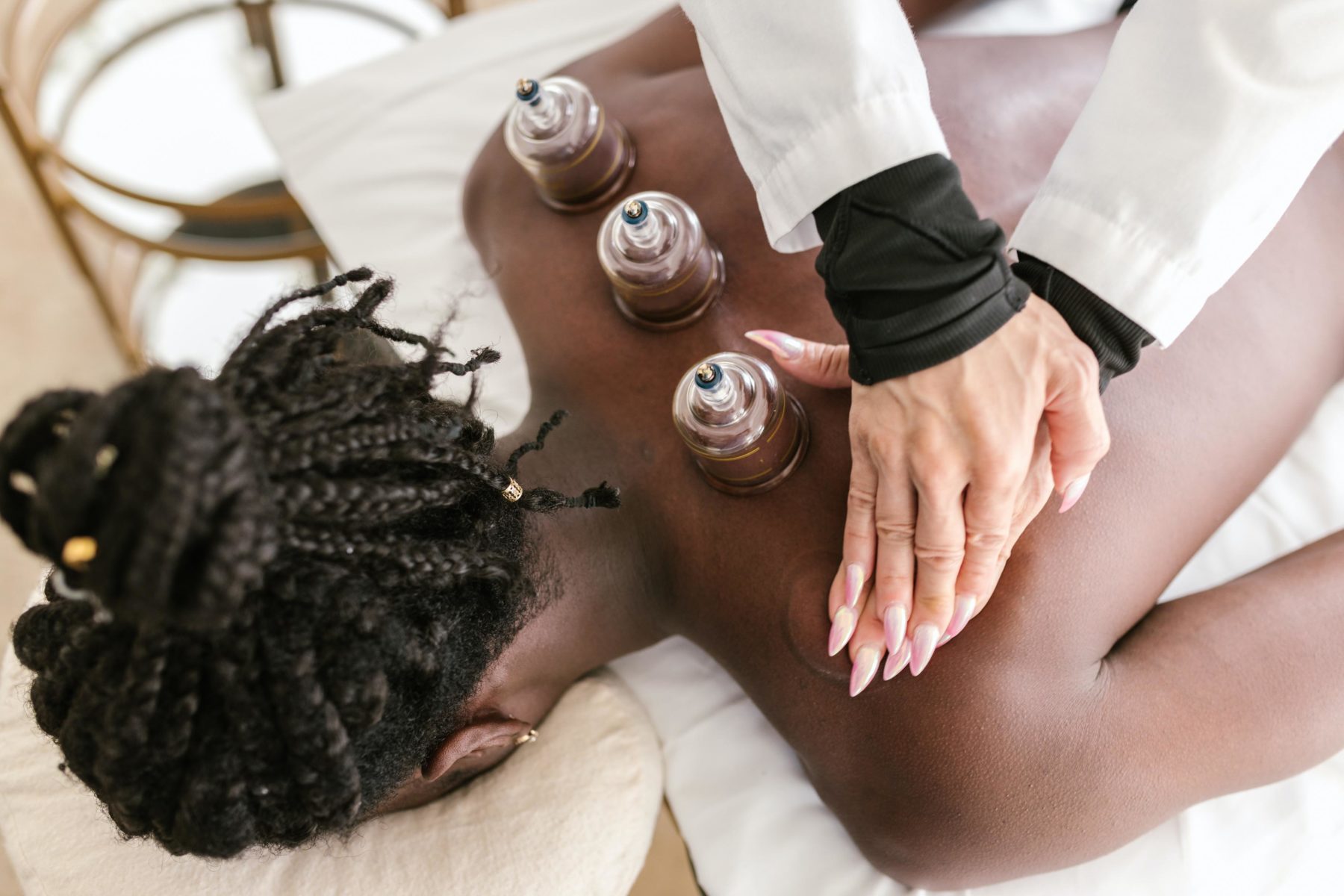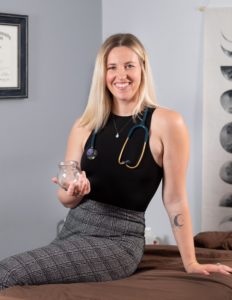Everything You Need to Know About Cupping Therapy

If you’ve been curious about this wellness modality, you’ve come to the right place. Cupping is a great modality for both chronic pain and anxiety. No matter what kind of cup you choose to use (and there are many) each one will pull up on hundreds of nerve endings, creating a sedating effect on your nervous system.
When you think about muscles and nerves alike, they really only do two things: muscles can tighten or loosen, while nerves can be more stimulated or less stimulated. So, when muscles are having a difficult time loosening on their own through stretching or other techniques, a better approach might include adding tension by applying a cup with negative pressure over the affected muscle group. In this way, you loosen by tightening. At this point, the muscles are aware of a great deal of tension and stagnation they have been holding. It’s as if your muscles have an “ah-ha” moment. This practice of loosening by tightening is deeply rooted in yin and yang theory; you cannot have one without the other and they exist together.
What is cupping?
All kinds of waste can get stuck in our muscles and fascia layers, including toxins from air pollution, food and chemicals as well as hormones, processed sugar and other parts of our food our bodies were never meant to process and digest. The cups increase blood flow by stimulating the capillary vessels and creating a suction that allows for the toxins listed above to be brought to the surface and processed through the lymphatic system. Cupping improves circulation and movement of the lymphatic system and dramatically improves metabolic processes, which keep improving with each subsequent treatment, and is wonderful for muscle recovery. Our nervous system, specifically, is impacted greatly when the cups are used along the paraspinal and sympathetic nerves by the spine. In acupuncture theory, these nerves are located near the back’s Shu points and stimulation of this region leads to a powerful sedating effect on the autonomic nervous system and the organs under its jurisdiction.

Although an injury can appear to be healing on the outside (as in there is no more bruising or bleeding, there are scars, and function is at least partially restored) there is a lot going on under the surface. Many people have seen cup marks before on a friend, the internet or Michael Phelps at the 2012 Olympics, and thought ‘Wow, those marks look dark and painful!’
What do the purple marks mean?
The dark purple color is a sign of underlying stagnation. What am I talking about when I say “stagnation?” When someone is injured, the body’s inflammation cascade begins, new blood rushes to the scene and, if the skin is cut, you see stagnated blood in the form of clotting (otherwise known as a scab) start to form. As one begins to heal from injury, a majority of the inflammation decreases and you return to your baseline level of range and function. However, remnants of that stagnation can stay in the muscle, joint or tendon affected.
Have you ever had a limited range of motion for months after an injury? For many, the answer will be yes. Depending on the severity of the event, your healing timeline will vary. Have you ever felt that, although the rest of you is back to normal, the affected area seems to be “sticky” or “does not move quite right?” This is one way you experience stagnation left over at an injury site. Using cups on the area to stretch the connective tissue involved allows for increased range of motion and even pulls out deep-rooted blood stagnation.
I know, it sounds too simple to be true. I have found that sometimes the greatest solutions lie in the simplest of theories. If you have some stagnation in your system, why not pull it out? If the pain or discomfort you are experiencing is not caused by an injury, that is when we would look at diet and lifestyle. For example, you can stagnate blood by being in one position too long (like sitting or working on the computer). You can also have stagnation due to emotions or the countless pollutants we are exposed to each day. Cupping will help drain these toxins into your lymph system and give your body the reset it needs.
What about the marks that are not purple?
The colors of the marks tell you what is going on in the area. Purple is stagnation, and the darker the marks are, the more severe. Red dots are blood heat (red means moderate stagnation) and black dots are severe toxins (which I have only seen working with veterans who were exposed to harsh chemicals and burn pits overseas). No color can be blood deficiency, and a bluish-white color, which goes away almost immediately after the cup is removed, is a pathogenic cold. These are all diagnoses your acupuncturist may give you in a session, but all you really need to know is that, if cup marks are dark, there is something in excess that your body is releasing — and that is awesome! The marks show that you have increased your self-care by helping your body get back to a state of optimal performance. Go, you! You will also be the conversation piece at any pool party and there is a good chance people will think you are really cool and have badass-looking marks on you. You may also be asked endless times if you got into a fight with an octopus.
Does cupping hurt?
For most of my patients, cupping feels somewhere between highly pleasurable to mildly uncomfortable. I never want the cupping I provide for someone to be painful. We are trying to get your body to relax and release. If you are in pain, I will adjust the cups to a level of suction where you feel good. The cups feel most intense when they are first put on and, for the first couple of minutes, your body will adjust to them — and then you may even forget some cups are there! On occasion, some feel some of the cups throughout the entire treatment and, how the cups feel varies greatly based on your constitution, what we are working on, and your pain threshold. After the initial session, you might notice a difference in your body and, the more sessions you have, the more your body will be accepting of the cups and the deeper the sessions will become.
For this article, I focused on chronic pain and anxiety; however, the benefits of cupping are seemingly endless. Cupping works for cellulite reduction, wrinkle prevention and reduction, chronic pain, carpal tunnel, some headaches, acne, digestive disturbances, relaxation, joint pathologies, postural alignment, relieving emotional strain, plantar fasciitis and so much more. Of course, there are some contraindications including, but not limited to, the first trimester of pregnancy, untreated high blood pressure, open sores or wounds, lymph-related cancer, acute injury (within 72 hours), and patients on blood thinners. Always consult your health care practitioner before starting a new modality.
How long does treatment take?
When dealing with chronic pain, it’s important to note that it is usually considered to be pain lasting longer than six weeks. That is all. How many of you have had pain for longer than six weeks? Welcome to the chronic pain statistic, how are you going to start addressing this? Since cupping has such a wide range of therapeutic actions, it would be a wonderful addition to your health routine.
For chronic pain patients, it is important to have a team of people helping you to achieve your health goals. Cupping may not fix everything, but it can help you. Most of my patients report a 50-70% pain decrease a week after each weekly session. Cupping is a beautiful adjunct to chiropractic work, acupuncture, physical therapy, personal training or other forms of mental health treatment. If your only goals are to reset your body, flush your lymphatic system and calm your nervous system, that is great too. You can find trained cupping therapy practitioners on the International Cupping Therapy Alumni Website. Many acupuncturists have training in cupping therapy as well. Cheers to your health and living painlessly!
About the Author
 Isabel Meijering is an acupuncturist in Austin, Texas, and is the owner of Admiring You Wellness. She has a B.S. in biomedical sciences with a minor in psychology and has a deep love for both eastern and western medicine, which started with her introduction to yoga and grew from there. While achieving her Master’s in acupuncture with a specialization in Chinese herbal medicine at AOMA, Isabel became a certified Tuina practitioner through the American Organization for Bodywork Therapies of Asia (AOBTA) with a specialization in cupping therapy through the International Cupping Therapy Association (ICTA). Meijering primarily focuses on pain management, as well as other sources of pain. Her goal is to get patients functioning in their lives the way they have always wanted to, or have not been able to because of pain. Isabel is currently working on her Doctorate in Acupuncture and Chinese Medicine through Pacific College of Health and Science.
Isabel Meijering is an acupuncturist in Austin, Texas, and is the owner of Admiring You Wellness. She has a B.S. in biomedical sciences with a minor in psychology and has a deep love for both eastern and western medicine, which started with her introduction to yoga and grew from there. While achieving her Master’s in acupuncture with a specialization in Chinese herbal medicine at AOMA, Isabel became a certified Tuina practitioner through the American Organization for Bodywork Therapies of Asia (AOBTA) with a specialization in cupping therapy through the International Cupping Therapy Association (ICTA). Meijering primarily focuses on pain management, as well as other sources of pain. Her goal is to get patients functioning in their lives the way they have always wanted to, or have not been able to because of pain. Isabel is currently working on her Doctorate in Acupuncture and Chinese Medicine through Pacific College of Health and Science.






